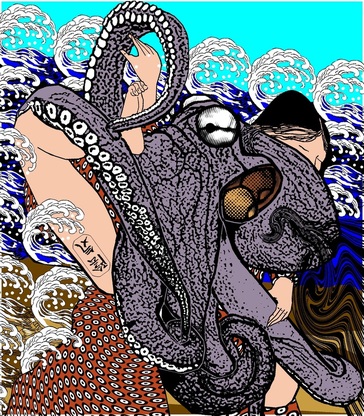Tessellations, Tentacles & Tattoo
 Caught (Bad Romance), 2013
Caught (Bad Romance), 2013
A printmaking matrix (e.g., a block, stone, plate, or screen) is a complex tool, the essential purpose of which is to acquire and hold pigmented material and apply it to a substrate (e.g., paper). This is exactly equivalent to the way brush can be used to acquire and hold paint and apply it to canvas. My matrix (stencil) is my brush.
Visually apparent halftones in my prints (i.e., dots, lines, and custom shapes) are metaphors for commercial printmaking, for current culture, and for new technology. Halftones carry tonal changes in the printed images and, when apparent, are also intrinsically interesting repeated forms.
Repetition, critical to composition, is a primary strength of printmaking. Tessellations are the best examples of this principle.
Traditional printmaking, combined with new technologies, can efficiently and precisely employ traditional and custom halftones, textures, tessellations, patterns, and unique, flat, complex, or "exploded" colors.
My screen printed images refer to other printmaking methods (e.g., textiles, woodblock), earlier times, and other cultural contexts (e.g., Japanese ukiyo‑e, Renaissance, and Pop Art).
Visually apparent halftones in my prints (i.e., dots, lines, and custom shapes) are metaphors for commercial printmaking, for current culture, and for new technology. Halftones carry tonal changes in the printed images and, when apparent, are also intrinsically interesting repeated forms.
Repetition, critical to composition, is a primary strength of printmaking. Tessellations are the best examples of this principle.
Traditional printmaking, combined with new technologies, can efficiently and precisely employ traditional and custom halftones, textures, tessellations, patterns, and unique, flat, complex, or "exploded" colors.
My screen printed images refer to other printmaking methods (e.g., textiles, woodblock), earlier times, and other cultural contexts (e.g., Japanese ukiyo‑e, Renaissance, and Pop Art).